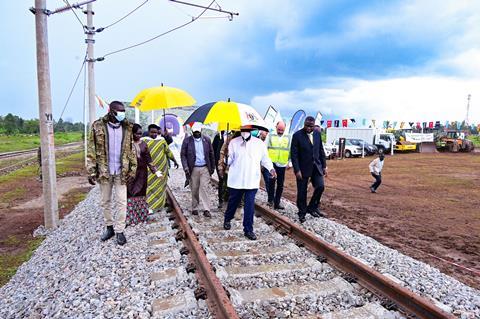
UGANDA: President Yoweri Museveni officially launched construction of the standard gauge railway programme’s 272 km Eastern Line from the capital Kampala to Malaba on the Kenyan border during a ceremony in Tororo district on November 21.
Museveni said the project is a ‘significant moment in our journey towards economy transformation, improving regional integration and advancing the aspirations of our people’.
Local benefits

The ceremony follows the signing on October 14 of a €2·7bn contract for Turkish contractor Yapı Merkezi to build the 1 435 mm gauge line, which will be electrified and have UIC60 rails, a 25 tonne axleload and design speed of 120 km/h. Construction is expected to take 48 months.
The Ugandan government requires 40% of the contract value to be allocated to domestic suppliers, to develop local capacity and ensure people will benefit from the project right from the start.
At the groundbreaking ceremony, Turkish Ambassador Fatih Ak said Turkey is happy to be part of Uganda’s journey toward prosperity, with the railway being a transformative project in driving long-term economic growth and regional integration.
Safe, reliable and cost-effective

Kenya is expected to begin work in January 2025 on the section of its standard gauge line which will connect with the Ugandan line at Malaba.
‘The two countries have agreed on the timelines of the two projects to ensure seamless movement of trains from Kampala to Mombasa’, said Uganda’s Minister of Transport & Works General Katumba Wamala.
President Museveni described Uganda’s current transport system as ‘irrational’, saying ‘roads are overcrowded with cars and cargo. This leads to slow movement, increased traffic and damaged roads. To solve this, cargo must move to railways and waterways, while petroleum products will be transported through pipelines.’
The SGR railway is intended to offer safe, reliable and cost-effective bulk transport. Museveni said transporting a 20 ft container from Mombasa to Kampala by train will cost 50% less than by road, with the time required reduced from 14 days to 24 h. The government expects the line to create more than 150 000 job opportunities both directly and indirectly, and to reduce road maintenance costs, increase exports, support regeneration of towns along the route and boost tourism.
The long-term vision for the SGR network includes the 465 km Northern line from Tororo to Gulu and Nimule at the South Sudan border, the Western line from Kampala to Bihanga, Kasese and Mpondwe on the DR Congo border, and the Southern line from Bihanga to Mirama Hills on the Rwandan border.

- Wamala said the government has decided to undertake rehabilitation works on the existing Malaba – Kampala metre-gauge line to complement the ongoing work on the Tororo – Gulu line, to enhance services while the standard gauge network is being developed.

















